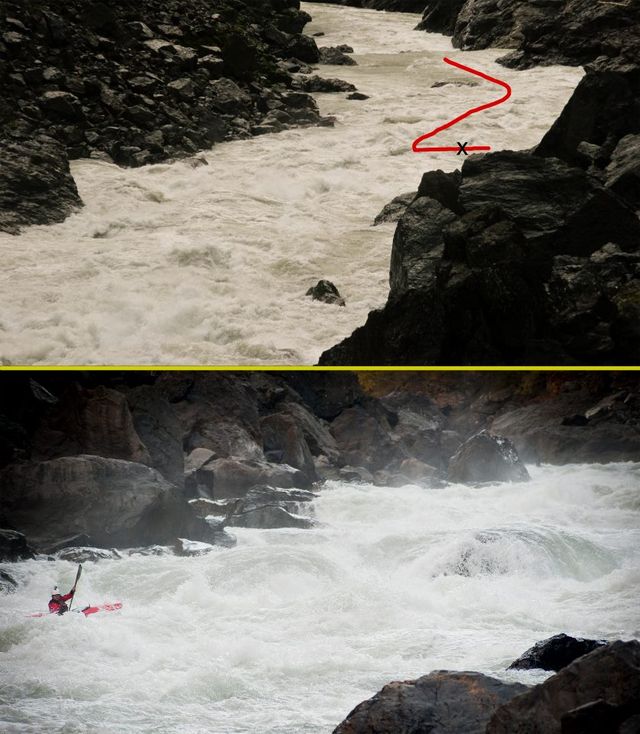
Kayaker Ben Marr became the first person to run the full Grand Canyon of the Stikine after he completed Site Zed, the last un-run rapid in the Class V canyon. Truck-sized waves, dangerous circulating eddies, and 1,000-foot-high canyon walls that make rescue difficult have led most adventurers to portage around the rapids. “The real danger at Zed is flush drowning,” says kayaker Rush Sturges, who has run the Stikine twice. “If you were to get caught in a feature and swim, you would be in for a rough time out of your boat. The water is frigid, and the air is generally brisk. Beyond the difficulty of the rapid and the danger, it is also the location, the remoteness, and the length of the rapid that makes it one of the most challenging on earth.”
The Stikine River is considered one of the ultimate testing grounds for expedition whitewater kayakers. The river begins on the Spatsizi Plateau in northern British Columbia and winds more than 350 miles north to Wrangell, Alaska, and the Pacific Ocean. For whitewater kayakers, the crux of the river is a roughly 45-mile-long stetch of Class V and Class VI rapids known as the Grand Canyon of the Stikine. , Rob Lesser led a team that made the first descent of the river. Less than have paddled it since then, though no one has successfully run Site Zed.
Expeditions normally paddle the river in three days, though one group earlier this year ran its length in seven hours. Marr put in August 19 with a group of seven that included Evan Garcia and Fred Norquist. The group camped by the portage at Site Zed on the first evening, with plans to hike around the river. As Marr walked by the rapids, he had second thoughts. “I could see that it was big, burly, but runnable, so I stashed my boat and started scouting,” he says. “After breakfast and more scouting the next morning, I put it up as a group decision to make sure everybody was OK with it.”
Everybody was, so Marr hatched a safety plan with the crew. Even with a good plan, he knew rescue was not a guarantee. “I had a Delorme inReach device to call in a heli rescue if I needed it,” he says. “But, had I swam, who knows when I would have gotten to shore and how hard it would have been for me to get to an acceptable spot for a heli.”
Marr's initial line involved avoiding being pushed left into two dangerous sections of the river. Here’s an edited version of his planned line, followed by a description of his run:
The most dangerous part of the rapid was halfway down on the left, two steep shallow pour overs pushing into a violent recirculating eddy. [I needed to run that] entrance right, but there were large diagonals after that feeding left. These were my main concerns and the crux moves of the run.
The first move went perfectly, which was a relief. The second move involved breaking another diagonal, generating enough left to right momentum so that I could paddle over the right side of a big wave and boof out over a pourover. This was the scariest part because there was a wave here that could push you all the way left into the nastiest spot in the rapid. I flipped here, but ninja rolled up fast and was in the middle of the flow. I allowed myself a little stoke here, but I still had a very large hole to punch. I wasn't too worried about the big hole. I knew I might get a small beating, but there was a chance I would just flush right through. After smashing into the giant feature I flipped again, but made it through fine. All that was left was the last drop. As long as I stayed middle/middle left, there were no big holes to worry about. The whole time I was in the rapid I just kept my mind on what was downstream and where I needed to be. While scouting, I had to look at a lot of plan B options if things were to go wrong. I was STOKED not to have had to get into any of those!
After navigating Site Zed, Marr went on to make the first complete descent of the river, reaching the take out on August 21. Sturges says the accomplishment pushes Marr's already high standing in the kayaking community to another level.
“Ben comes from a big wave freestyle background. In other words, he's been recognized in the sport
for his freestyle prowess and only recently for his steep creeking and big
water skills,” says Sturges. “This past season, we both completed the biggest rapids on earth
along with Steve Fisher and Tyler Bradt. I have no doubt that this experience
has been pivotal in changing our perspectives on what is possible on the big
volume frontier. Benny has been killing it forever, but it's awesome to see him
finally getting some recognition as a top all-around kayaker.”
—Joe Spring